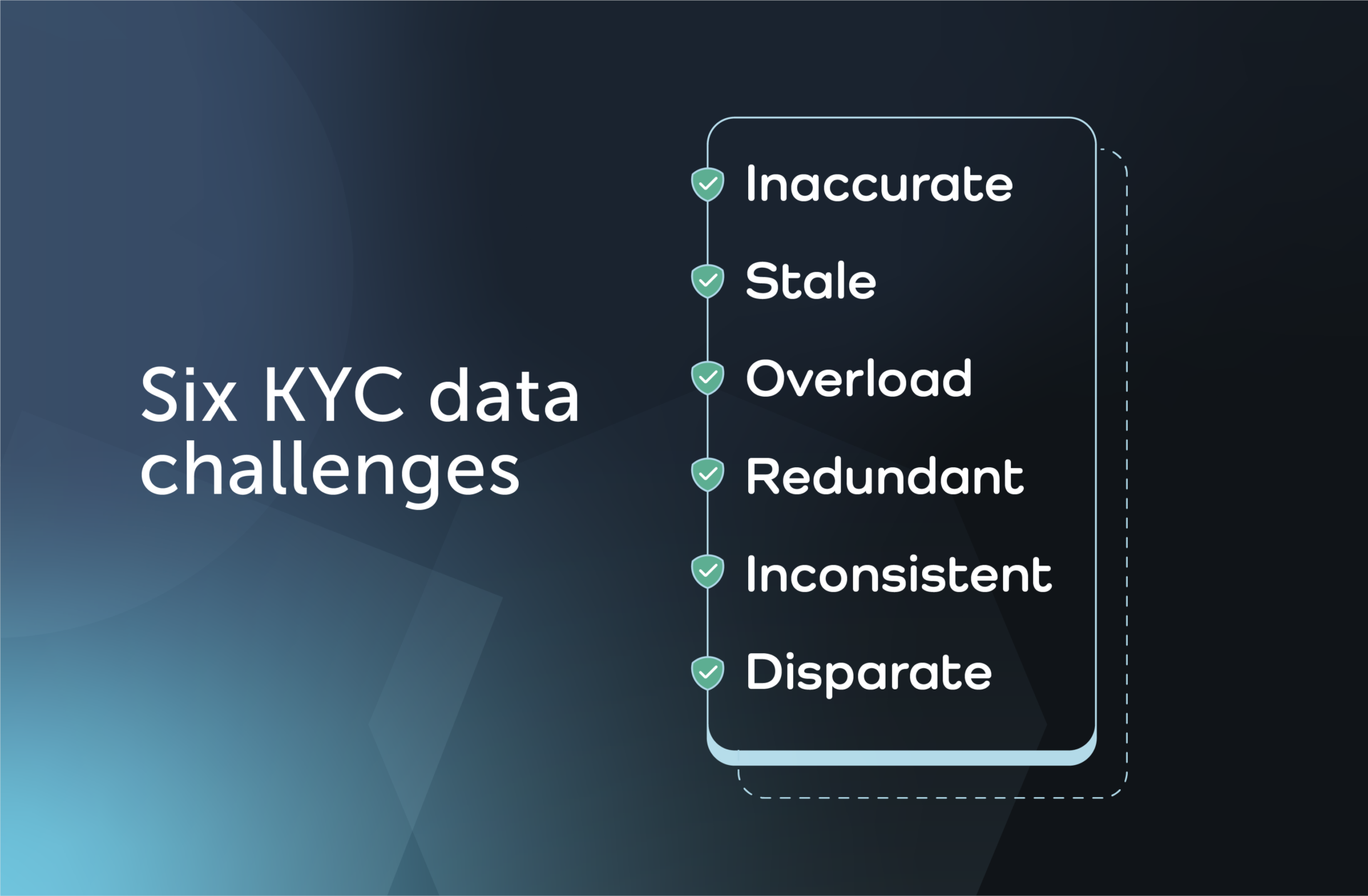KYC challenges for banks: six key questions on entity data management

For corporate banks, overcoming KYC challenges is critical to maintaining compliance and streamlining operations.
From managing fragmented data sources to ensuring real-time updates, financial institutions face increasing regulatory pressures that demand more efficient processes. This blog explores the top KYC challenges for banks today and highlights how automation and advanced entity data management can provide a scalable solution.
The KYC data challenge: What’s holding banks back?
KYC remains a significant operational and compliance challenge for corporate banks. Regulatory expectations are growing more complex, while traditional processes, often reliant on fragmented, manual data collection, struggle to keep up.
The core challenges banks face include:
-
Fragmented and inconsistent data sources, making it difficult to build a complete and accurate client profile.
-
Redundant or outdated information, leading to inefficiencies and potential compliance risks.
-
Lack of real-time updates, which hinders proactive risk management and increases reliance on periodic reviews.
-
Difficulty in verifying data origin and trustworthiness, complicating due diligence and slowing onboarding.
-
Manual processes that lack scalability, especially as banks handle increasing volumes of client data.
These obstacles make it harder for banks to maintain accurate, up-to-date client information and meet regulatory standards efficiently. The solution lies in improving how data is accessed, verified, and managed across the KYC lifecycle.
Here are six key questions banks should be asking themselves to address these challenges and unlock smarter, scalable KYC processes…
How can I ensure I am using accurate data?
Identifying and verifying data across multiple sources can often lead to time-consuming manual checks and inconsistencies. Encompass addresses this with automation rules that actively collect, combine, and organize real-time public KYC data.
Additionally, Encompass uses customizable logic to evaluate each data point from multiple sources. The platform automatically cross-checks key information, such as beneficial ownership, legal status, and address details, against reputable and up-to-date sources. Discrepancies can be flagged for review, based on the bank’s predefined rules, prioritizing the most reliable source, or prompting further investigation.
Hierarchy rules and entity resolution are applied to ensure data consistency, in accordance with the banks defined policy. For example, if one source is designated as the most dependable for beneficial ownership, that data is automatically prioritized, reducing conflicting data points. Furthermore, the platform continuously monitors changes in external sources to update client profiles in real-time. This enables banks to keep records accurate without manual intervention.
What can I do to avoid using redundant data sources?
Banks should prioritize a consolidated approach that reduces duplication, organizes data flow, and includes robust data entity resolution. Additionally, banks should streamline their data requirements as a first step to ensure only those data points which impact client risk assessment are monitored.
Relying on multiple public and private sources can lead to conflicting information, duplicative work, and operational slowdowns. This fragmentation can create confusion, reduce efficiency, and introduce risk if outdated information is used.
Encompass addresses these challenges by centralizing client data into a single platform, integrating multiple sources for a unified 360° view of each corporate client. This comprehensive perspective ensures that compliance teams, relationship managers, and other stakeholders have access to consistent, verified information, which enhances decision-making and minimizes conflicting data points.
How can I better understand which source contains which attribute?
Knowing exactly which attributes come from which source is essential for effective risk assessment. Encompass supports attribute mapping, providing a clear view of where each data point originates, its level of reliability, and its last update. By documenting and organizing data sources, Encompass simplifies the process of retrieving specific information. This not only aids compliance but also ensures teams work with precise data for faster, more accurate onboarding.
How do I keep up with changes with data sources and optimize my KYC data?
As data sources evolve, so does the need for current information to support compliance and risk assessments. Encompass delivers the most current information from a data source upon a client’s request to check that source for a specific entity. This allows the bank to review and identify any material changes that may have occurred.
Is it good practice to combine data from different data sources?
To build a complete picture of each corporate client, Encompass normalizes data attributes from multiple public data sources and vendors. This standardization process eliminates conflicts and ensures consistency for consolidated smooth data ingestion.
Rather than dealing with scattered information, banks can access a single, consolidated profile, with high-quality data curated from the most reliable sources. By seamlessly combining structured and unstructured data, banks achieve deeper client insights that enhance both risk assessment and client satisfaction, with a full audit trail of every action taken.
How can I eliminate stale data with perpetual KYC?
Perpetual KYC (pKYC) revolutionizes how financial institutions manage client data by continuously monitoring and updating information in real time. Effectively eliminating stale data to provide an up-to-date KYC risk assessment. Unlike traditional KYC processes, which rely on periodic reviews, pKYC proactively ensures that client profiles remain accurate and current, significantly reducing compliance risks.
Delivering a 360-degree view of a client with a digital profile, creates a comprehensive understanding of each client. Automated systems continuously track changes in client information as part of pKYC programs, such as beneficial ownership and legal status. Real-time alerts notify banks of significant updates, allowing for immediate review and corrections. This dynamic validation cross-checks latest information against existing profiles, quickly identifying, and resolving discrepancies, while the integration of diverse data sources enhances the reliability of insights.
The Encompass advantage to optimize KYC data
Effective KYC relies on high-quality data and efficient processing. Encompass’s centralized, automated solutions support the KYC journey, from data verification to validation. Banks can transform their KYC processes into streamlined, compliant, and client-focused experiences, delivering better insights and stronger compliance with fewer resources.
For banks looking to reduce data management complexity and improve KYC outcomes, Encompass Corporation provides the technology to make it possible.
Discover corporate digital identity from Encompass